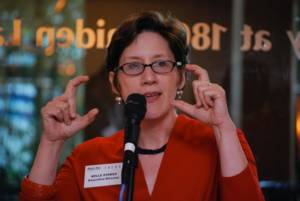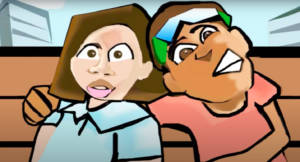
Game Design: An Interview with Barthelemy Atsin and Nelle Stokes

In December, New York State approved LIHSA’s three new CTE programs. We will begin offering Sonic Arts, Expressive Arts in Human Development, and Game Design programs during the 2021-22 academic year. This week we’d like to share more information about one of our new programs – Game Design – with our LIHSA Community and share additional information about the program through an interview with two industry experts: one of our talented Artists-In-Residence, Barthelemy Atsin, and Magic Box Production’s Founder and Executive Director Nelle Stokes (see their bios below).

About Game Design
The Game Design curriculum provides grounding background in the design, story-telling, illustration and 3D animation and in-depth game development coursework. Students learn to conceptualize, iterate and produce games that fit their artistic visions as well as their career goals. Game Designers author the storyline, writing the plot points, character development, and game objectives that drive the game. Students will learn the twenty-first century skills of creativity, critical thinking, communication, collaboration, and technical expertise, which will increase employment capacity across the job market. In the Game Design pathway students prepare for both entry-level employment and additional postsecondary training needed for advancement in the highly competitive game design industry. Students completing this pathway develop the skills and knowledge to be creative partners in video game design while building capacity for employment in all areas of the creative workforce.
LIHSA’s Game Design students will find work in a number of areas including job titles such as: Game Designer, Storyboard Artist, 2-D and 3-D Animator, Mobile App Designer, Interactive Art and Media Consultant, Visual Effects Designers, Production Team Manager.
An Interview with Barthelemy Atsin and Nelle Stokes
Why do you think Game Design is an important CTE Program for LIHSA to offer?
Nelle Stokes: It is really smart for LIHSA to offer Game Design. This is one of the biggest industries in our country right now. And students just “get it.” They are fluent in this language and have an ease of using digital.
Think about how games make someone want to “die” over and over again; and we do – we come back over and over to move up in levels. Gaming teaches users about reiteration and the way people learn. And at LIHSA, students will have the opportunity to express themselves as artists through this medium. It’s very exciting!
Barthelemy Atsin: Game design is a way for students to open up and understand what makes them connect, especially as teenagers. What I’ll be teaching at LIHSA is how to incorporate an interesting story into a theme. I played games all my life and specific games have meaningful storylines that I remember even as an adult. It’s important to have a story telling process in animation and game design. I ask students to ask themselves what do you take from a game that you’ve played and apply it something you can create currently. This can be anything from a small scale animation, or something bigger that they can construct like a game. When I work with students, they create personalized characters and then moving forward, they have these as the foundations to build on.
We dive into why people connect to a game like Street Fighter. When I play, I feel like I’m a part of this story, relate to character. Gaming is often about find a place to belong. Since I’m a fan of the world, I help the students to open up. I understand what makes them connect, especially as teenagers.
Where do you think will be the opportunities for students studying Game Design in the future?
Nelle Stokes: There are huge opportunities in this field. There are Virtual Reality programs for engineers, doctors and med students, for example. There will be applications we haven’t thought of yet. Students studying game design will be prepared for jobs that don’t even exist yet!
Barthelemy Atskin: It can take them anywhere! One of the most fascinating things about gaming in general is that it has so many aspects: I’ve gotten to be involved both from a graphic design and an acting perspective. I get to see how it all works. I actually voiced two different characters in Red Dead Redemption 2. From an acting aspect, it’s so cool seeing your voice come to life in a digital world.
What has your journey been in the Game Design Field?
Bathelemy Atskin: Mostly animation, I’m all about animation. I incorporate animated ideas into illustrations and create after affects. Acting in Red Dead Redemption 2 was a blessing that fell into my lap. Rock Star knew who I was, and contacted me. I feel so lucky!
Nelle Stokes: I started my career working for PBS in Florida, eventually moving to New York to attend grad school at NYU. I was making films and writing when a friend recruited me to work with 5th graders at an after-school program. We made movies and created projects and that’s when I discovered how much I loved being a Teaching Artist. Later I founded Magic Box Productions – a nonprofit organization that focuses exclusively on media arts educational opportunities for K – 12 students. We work with an average of 2000 students per year in all aspects of digital arts: animation, documentary, web work, podcast and photography. We’re now in our second decade, and have worked with over 20,000 students, parents and teachers. Even throughout the pandemic, since we were already working digitally, we were able to transition and keep working.
As a parent, I’ve watched our two children grow up with games and gaming. They both still play, and use those strategies in a lot of different ways.
What is a piece of advice you’d offer to potential students considering entering the Game Design Program?
Barthelemy Atskin: Students should be open to collaborating and also be really aware why people like certain games. They should ask themselves why are some games so popular, like Super Mario. People who play video games emulate them, play games in tournament, play in professional league. The level of engagement is why they have they lasted so long. Students should stay open to all the art forms and bring them together. All the elements that go into games like voice over, character design, and music stay with you forever.
Squad: Animation by Barthelemy Atskin

About Barthelemy Atsin
Originally from Philadelphia, Barthelemy is a graduate of Marymount Manhattan College and is an alumni of SVA’s After Effects and Photoshop program intensive. He’s studied Shakespeare at Balliol College and performed live throughout Oxford. He’s collaborated with Elizabeth Swados on developing children’s books and created backdrops for La Mama’s main stage performances. He premiered his first animated children’s show, Kids Play, on the BRIC Free Speech Network in Brooklyn. Barthelemy’s work can also be seen in shows such as Master of None, Boardwalk Empire, Person of Interest, Mr. Robot, Billions and Hunters on Amazon Prime. Barthelemy voice’s can also be heard in Rockstar’s Red Dead Redemption II. Check out more of his work at www.artwithbart.com or on his Youtube channel called Art with Bart.
About Nelle Stokes
Nelle Stokes is Founding Executive Director of Magic Box. She is a member of the Media Arts Writing Team for the National Coalition for Core Arts Standards (NCCAS), and a contributor and Steering Committee member for the NYC DOE’s Blueprint for Teaching and Learning in the Moving Image: Grades K–12—the first sequential and comprehensive guide to media education programs.
Nelle has designed curricula for schools and partnerships throughout New York City, and presents regularly on media arts issues at local and national conferences. She is also an award-winning documentary filmmaker.